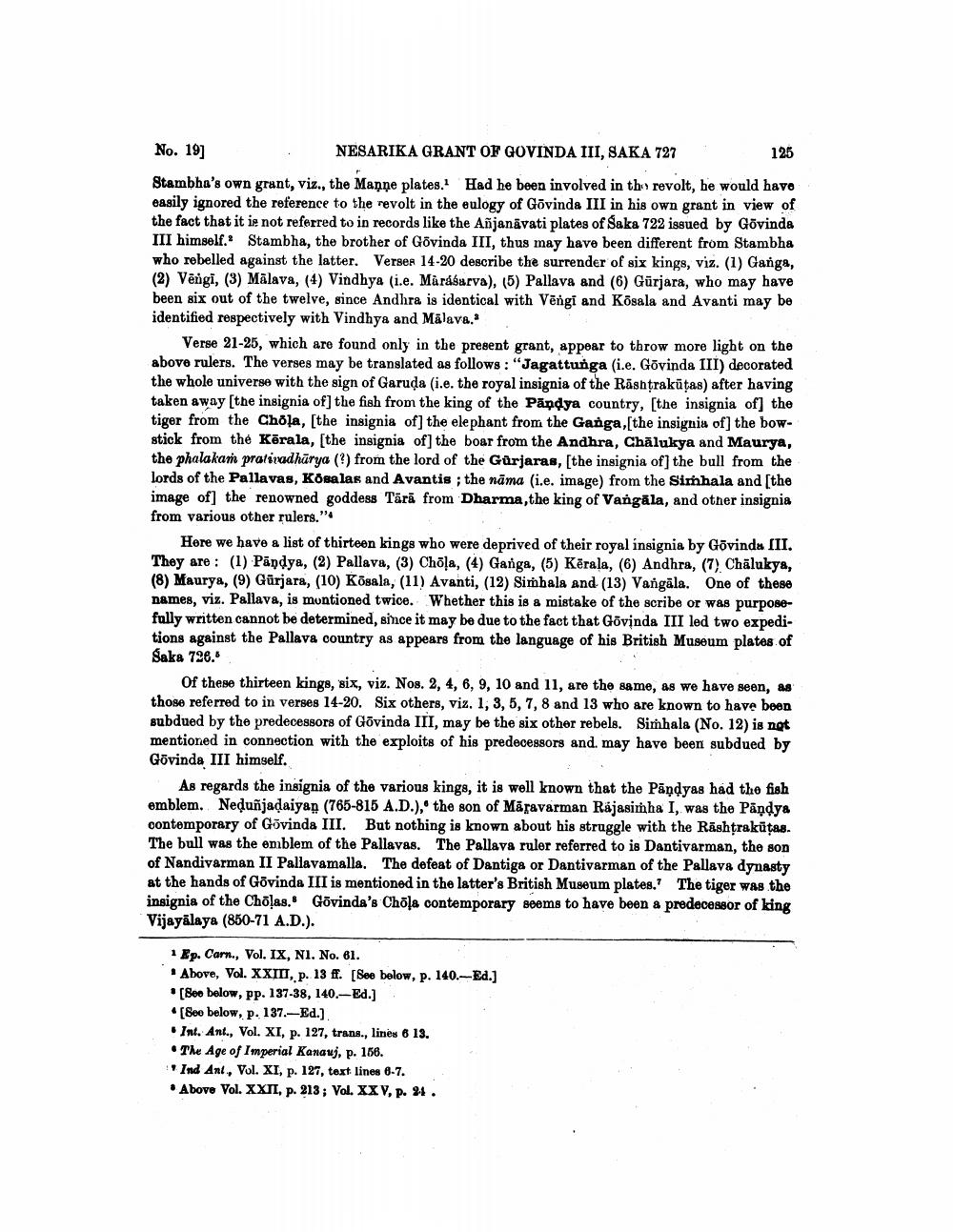________________
No. 19) NESARIKA GRANT OF GOVINDA III, SAKA 727
125 Stambha's own grant, viz., the Manne plates. Had he been involved in the revolt, he would have easily ignored the reference to the revolt in the eulogy of Govinda III in his own grant in view of the fact that it ie not referred to in records like the Añjanävati plates of Saka 722 issued by Govinda III himself. Stambha, the brother of Govinda III, thus may have been different from Stambha who rebelled against the latter. Verser 14-20 describe the surrender of six kings, viz. (1) Gange, (2) Vengi, (3) Mälava, (4) Vindhya (i.e. Märásarva), (5) Pallava and (6) Gürjara, who may have been six out of the twelve, since Andhra is identical with Vëngi and Kösala and Avanti may be identified respectively with Vindhya and Mälava.
Verse 21-25, which are found only in the present grant, appear to throw more light on the above rulers. The verses may be translated as follows: "Jagattunga (i.e. Govinda III) decorated the whole universe with the sign of Garuda (i.e. the royal insignia of the Rashtrakūtas) after having taken away (the insignia of] the fish from the king of the Pandya country, [the insignia of] the tiger from the Chola, [the insignia of] the elephant from the Ganga,[the insignia of] the bowstick from the Kērala, [the insignia of] the boar from the Andhra, Chalukya and Maurya, the phalakaṁ pratiradhārya (9) from the lord of the Gürjaras, [the insignia of] the bull from the lords of the Pallavas, Kosalas and Avantis ; the nāma (.e. image) from the Simhala and (the image of] the renowned goddess Tärä from Dharma, the king of Vangala, and other insignia from various other rulers."
Here we have a list of thirteen kings who were deprived of their royal insignia by Govinda III. They are: (1) Pandya, (2) Pallava, (3) Choļa, (4) Ganga, (5) Kerala, (6) Andhra, (7) Chälukye, (8) Maurya, (9) Gürjara, (10) Kõsala, (11) Avanti, (12) Simbala and (13) Vangāla. One of these names, viz. Pallava, is muntioned twice. Whether this is a mistake of the scribe or was purposefully written cannot be determined, since it may be due to the fact that Govinda III led two expeditions against the Pallava country as appears from the language of his British Museum plates of Saka 726.
Of these thirteen kings, six, viz. Nos. 2, 4, 6, 9, 10 and 11, are the same, as we have seen, as those referred to in verses 14-20. Six others, viz. 1, 3, 5, 7, 8 and 13 who are known to have been subdued by the predecessors of Govinda III, may be the six other rebels. Simhala (No. 12) is not mentioned in connection with the exploits of his predecessors and may have been subdued by Govinda III himself.
As regards the insignia of the various kings, it is well known that the Pandyas had the fish emblem. Neduñjadaiyap (765-815 A.D.), the son of Måsavarman Rájasimha I, was the Pandya contemporary of Govinda III. But nothing is known about his struggle with the Rāshtrakūtas. The bull was the emblem of the Pallavas. The Pallava ruler referred to is Dantivarman, the son of Nandivarman II Pallavamalla. The defeat of Dantiga or Dantivarman of the Pallave dynasty at the hands of Govinda III is mentioned in the latter's British Museum plates. The tiger was the insignia of the Cholas. Govinda's Chola contemporary seems to have been a predecessor of king Vijayālaya (850-71 A.D.).
1 Ep. Carn., Vol. IX, NI. No. 61.
Above, Vol. XXIII, p. 13 ff. [See below, p. 140.--Ed.) [See below, pp. 137-38, 140.--Ed.) •[800 below, p. 137.-Ed.). . Int. Ant., Vol. XI, p. 127, trans., lines 6 13. • The Age of Imperial Kananj, p. 156.
Ind Ant., Vol. XI, p. 127, text lines 6-7. . Above Vol. XXII, p. 213; Vol. XXV, p. 21.




